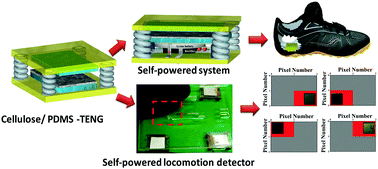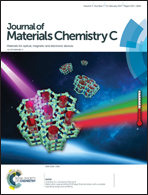A microcrystalline cellulose ingrained polydimethylsiloxane triboelectric nanogenerator as a self-powered locomotion detector†
Abstract
Scavenging of ambient dissipated mechanical energy addresses the limitations of conventional batteries by providing an auxiliary voltaic power source, and thus has significant potential for self-powered and wearable electronics. Here, we demonstrate a cellulose/polydimethylsiloxane (PDMS) triboelectric nanogenerator (C-TENG) based on the contact and separation mode between a cellulose/PDMS composite film and an aluminium electrode. The device fabricated with a composite film of 5 wt% generates an open circuit voltage of 28 V and a short circuit current of 2.8 μA with an instantaneous peak power of 576 μW at a mechanical force of 32.16 N. The C-TENG was systematically studied and demonstrated to be a feasible power source that can commute instantaneous operation of LEDs and act as a self-powered locomotion detector for security applications. The C-TENG can also be used as a wearable power source with an in-built lithium ion battery charging circuit during a range of human motions.



 Please wait while we load your content...
Please wait while we load your content...